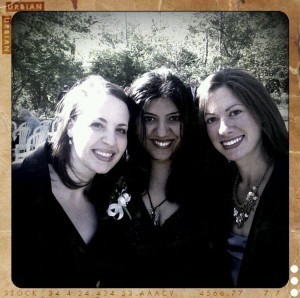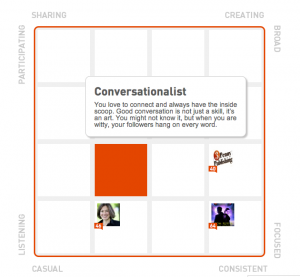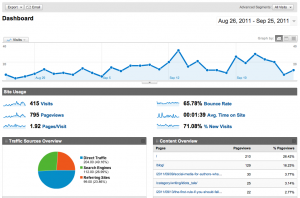Sarah Cypher's Blog, page 12
October 25, 2011
In defense of the Jesus-flipping-Christ English language, people.
In response to this unsuspecting blog entry, some vulgar grammarians have it out in the comments section. I'm sharing because it made me laugh, the same voyeuristic way it makes me laugh when two cars block a four-way intersection, horns blaring, demanding the right-of-way.
[image error]
Brononymous 4 months ago
Be more cliche.
[image error]
Woyzeck 4 months ago in reply to Brononymous
"Cliche" is not a fucking adjective. Jesus fucking Christ, people.

Elle 4 months ago in reply to Woyzeck
It can be a noun or an adjective. Chill out.
[image error]
Woyzeck 4 months ago in reply to Elle
No it can't, it's a noun.
[image error]
Brononymous 4 months ago in reply to Elle
She's right ya douche
[image error]
Brononymous 4 months ago in reply to Brononymous
(Elle, not Woyzeck)
[image error]
Douche. Really? 4 months ago in reply to Brononymous
Except, the way you're using it as an adjective it'd be 'cliched'. So, no, wrong twice.
The verdict: While several contestants lose points for comma splices and incorrect punctuation, the match goes to Woyzeck for proper use of tmesis.
Some goals, and the not-quite WIP
Since finishing SHAHIDA in April (and again in August), I've been researching the next novel. It is a low-level obsession, always at a simmer, which is how I know the idea has the staying-power to keep me interested in the project for the next two to three years. Still lacking an outline, or even a logline, I cannot call it my work-in-progress yet: But I can finally identify the obsession. It's that America has been at war for ten years, but until I met my wife, who is a decorated participant therein, it was easy to, well… forget, most days, that we are fighting.
From this side of the gun (or console), why does war look so much like peace? Should it?
Is it a war between the United States and al-Qaeda, or between the nation-state and a borderless state?
What does victory look like? How do we know for sure if we've won?
Who is responsible for this quasi-amnesia, and is it needed to win a war on terror?
What does Internet freedom have to do with it?
I know the standard answers to these questions. Those answers fit on placards. The longer versions fit in op-eds. But there is a dystopia, a speculative novel, something, simmering between the lines, too. My goal is to outline the story soon, and then fill a few more months with research; I will say more later, but for now, I trust there is an important effect on human identity, and therefore relationships, that matters here. And that effect is worth a novel.
Besides that goal, here are the others in no order: Finish the marathon on Nov. 13. Stay on schedule at work. Plant some flowers around the tree in the backyard. Find a damn agent, finally. Walk the dogs in this beautiful warm autumn weather. Sleep well two nights in a row. And life is good; therefore, to live it in awareness that it is not good for everyone, and write something that might make a difference.
October 19, 2011
Absolut God: A review of Capek's timeless satire
 The Absolute at Large by Karel Čapek
The Absolute at Large by Karel Čapek
My rating: 4 of 5 stars
The Absolute at Large is a deft, straightforward, drily laugh-out-loud satire on spiritualism. When a frazzled inventor accidentally invents a nuclear power engine that offgasses God, a.k.a., the Absolute, he begs his old friend and industry baron to buy the machine and get it off his hands. As its curious byproduct converts factory workers, board members, bankers, and innocent bystanders to rapturous spirituality, neither capitalism or Marxism can withstand its effects on society–and the Catholic Church is the first to admit that God has no place in human religion.
The book is full of wry one-liners and absurd humor, such as the Church's belabored decision to baptize God into its ranks, and a dean's indignant belief that a scholar of religion has no place believing in God. Sarcasm is surprisingly ageless; written in the twenties, the novel and its humor keep quite well, and remind me sometimes of P. G. Wodehouse's prolific Jeeves series.
But it's not a novel to read either for its subtlety, for its beauty, or its generosity toward humanity. Enjoy Capek for his wit and spare writing style, and his ability to lay out a concise satire despite an enormous number of characters. If you read it, read it quickly, don't expect to get attached to the characters, and do expect its value as a novel to lie almost completely in its humor. As such, it's a great example of social science fiction–it asks a straightforward, "What if?" and follows it through to its logical consequences.
I would have given it three stars had I not finished it in two short days. And because I'm now reading Diana Abu-Jaber's Birds of Paradise, I can't resist a food comparison: as fiction, it's a savory snack, but nowhere near a full meal.
October 17, 2011
Defining marriage, one friend at a time.
Last week began with a phone call in the dark hours of Monday morning and ended 1,233 miles away in Miamiville, Ohio. In other words, it began with a death and ended in a wedding; and along this arc between one human experience and another, I felt a Merlin-esque sense of aging backwards, of seeing still-young friends gathered in hope and celebration while at precisely the same time, my wife attended her 48-year-old aunt's funeral.
 A friend says that the more you cry, the more room you make in your head for information. He was trying to put a silver lining on being a frazzled medical student–but there is some general wisdom here, too. As two people who do not often cry, my wife and I felt sort of blown open by loss and love. And this is good. Because life is short, and it's hard to remember exactly what love is, and all the forms it takes; but when I found myself crying at Mari's bedside and several days later at Faith's wedding, moved by emotions I couldn't articulate, my mind kept traveling back to a wordless sense of how much I loved my wife and how much we depend on each other's love. And from that, I felt more empathy than I thought possible for Mari's bereaved family, and for Faith and Travis's joyful new marriage.
A friend says that the more you cry, the more room you make in your head for information. He was trying to put a silver lining on being a frazzled medical student–but there is some general wisdom here, too. As two people who do not often cry, my wife and I felt sort of blown open by loss and love. And this is good. Because life is short, and it's hard to remember exactly what love is, and all the forms it takes; but when I found myself crying at Mari's bedside and several days later at Faith's wedding, moved by emotions I couldn't articulate, my mind kept traveling back to a wordless sense of how much I loved my wife and how much we depend on each other's love. And from that, I felt more empathy than I thought possible for Mari's bereaved family, and for Faith and Travis's joyful new marriage.
As a writer, I spend a lot of time thinking about the human experience. And I probably spend more time than is good thinking about politics and arguments and fairness and what "ought to be done." But weddings, funerals, reunions, babies, journeys, dreams at night; we can't control those, but they remind us of ourselves in relation to other people. Faith and Travis's minister knows this, too, because after the "I do's," he asked for a series of "We will's" from the audience; e.g., "We will recognize their union," "We will listen without judgment when they need us." Modern marriage creates vows between all people in a community, not just the bride and groom, because those ties will be important as life gives us more and more events beyond our control.
 My wife and I, we had no wedding. DADT existed at the time, and DOMA still exists. Sometimes I hedge on talking about my personal life, out of fear that when I say "wife" the person I'm talking to will startle a little behind their eyes and I'll see it; and then have to embark on a lot of aimless chattering while they figure out whether their opinion of me is different because I'm not as heterosexual as they had assumed. (It happens about 30 percent of the time. And it's always uncomfortable.) But this weekend at the wedding I couldn't help talking about my wife because I missed her so much, and in return, I was met with the most commonplace and kind responses. People asked me about her. We talked about our spouses, our jobs, our homes.
My wife and I, we had no wedding. DADT existed at the time, and DOMA still exists. Sometimes I hedge on talking about my personal life, out of fear that when I say "wife" the person I'm talking to will startle a little behind their eyes and I'll see it; and then have to embark on a lot of aimless chattering while they figure out whether their opinion of me is different because I'm not as heterosexual as they had assumed. (It happens about 30 percent of the time. And it's always uncomfortable.) But this weekend at the wedding I couldn't help talking about my wife because I missed her so much, and in return, I was met with the most commonplace and kind responses. People asked me about her. We talked about our spouses, our jobs, our homes.
And likewise, 1,233 miles away at the funeral, my wife's family asked her where I was and said to say hi.
We are married, one friend and family member at a time, every day. And this is what I want to say: There is nothing more political than living in your own skin honestly.
October 10, 2011
Breast cancer is not a pink ribbon.
I spent the weekend watching my partner's aunt in her last days of life. Maricela Ochoa passed on this morning around 5 a.m. after a five-year fight with breast cancer. She was 48. I knew her as cool Tia Mari, the , the activist, the 5'3″ spitfire with a voice the size of her native Texas, the woman who outlived her doctor's dead-end timeline by over two years.
Sometime around midnight on Saturday, it began to piss me off that NFL players wear pink gloves and shoes, that the cable music channel displays a pink ribbon, that you can buy all kinds of things in powder pink to make a statement. I was standing in the living room at the head of Mari's hospital bed, looking at the fissure lines on her skull that showed beneath her dark fuzz of hair. For hours she made choked, drowning sounds; the sound of barely not suffocating, of having a 5'3″ body full of malfunctioning organs. Her skin was faintly greenish-purple, as if the light around her bed were distorted. She had not eaten or had water in four days; and her mouth–with its trim, exact lips and perfect teeth–hung open. I wondered about the lines she had spoken onstage and before cameras, the slogans she chanted in antiwar protests, the countless times her mouth opened and closed in her life to give shape to the billowing ribbons of opinion, feeling, and confession that run through us all.
Whereas pink ribbons have absolutely nothing to do with cancer. Just like yellow ribbons haven't got a damn thing to do with our kids who die in the desert; nor does the flag pin, that glorified tie tack, do enough to stop our elected leaders from sending them there. Not all symbols are created equal. I believe Tia Mari would agree with me that there is neither a factory nor a product designer in the world that can manufacture a symbol that makes us feel, in our very bones and tissues, how fragile we are. How fragile all of us are, and that our body's inevitable termination demands the most constant and careful self-questioning about what it means to be brave, to have compassion, and exist as much as possible in a state worthwhile to other people.
I learned to write in a school that advises writers to tell every story as if to a dying person. More than ever, today I try to imagine dying: Like everybody else, I can't take my body. I can't take symbols. I have to go without language, my life's biggest asset and biggest crutch. What matters then? If I am to be a victim of cancer, or some other awful and average killer, what matters is that the people whom I loved know precisely how much I loved them. That my wife is OK. That I spent enough of my time doing things that made me feel excited or passionate or humbled; that a few of those things give my family a feeling of vicarious pride. All good storytelling requires empathy of both the teller and the listener, so in my last days of life I hope I can still listen to a story. I want that story to be so colorful, so specific, so powerful, and so meaningful that I can't tell the difference between its life and mine.
Cancer is a way that living things die–people, dogs, mice. It is a natural killer. Cancer dollars will never buy a satisfactory cure, because who is ever ready to leave? It is hard enough to smile for the dying. It is like trying to lift a house. I imagine Mari must have understood better than anyone that life is no rehearsal, and we need the most colorful, specific, powerful, and yes, meaningful, memories to relive when we are too weak and too medicated to open our eyes again.
Congrats, Mari. Your life is big. I wish I could have seen you act in your favorite play, but I'm a better person for at least having heard your voice, some of the strong things you said with it, and seen you just last week singing and dancing to spite your cancer. I think it's awesome that less than a month ago you were in a Huffington Post article, and you yourself said, "We're living. We're human beings. We're not just a little pink ribbon."


[image error]

October 7, 2011
A Heretical Complaint: Reading a Loveless Gabriel Garcia Marquez Novel
 Love in the Time of Cholera by Gabriel García Márquez
Love in the Time of Cholera by Gabriel García Márquez
My rating: 3 of 5 stars
I spent two weeks of my reading life. That's how long it took to get through Love in the Time of Cholera. I read first with a kind of tingly enthusiasm, reunited with the work of one of my favorite authors. Then with a growing sense of duty. Then with fear that the novel's sprawling backstory was really going to account for all six hundred and twenty-two (give or take) of Florentino Ariza's lovers as he grew to old age, waiting for Fermina Daza to become a widow.
Perhaps it is unfair of me to expect brilliance from all of Gabriel Garcia Marquez's novels, but 270 pages in to this one, I finally succumbed to the temptation to scan. I slowed for the final fifteen pages, which reinforced my view of Florentino Ariza as a tepid protagonist. He made me think of leeches, parasites, little rodents living in the wall.
For a novel ostensibly about love, the only reciprocal love I believe is that of Jeremiah de Saint-Amour and his Haitian lover. All else feels stained by conditions, regret, empty lust, and equally empty longing. These are the faces of other loves, yes, but they lose even this credibility by Gabriel Garcia Marquez's final failure to make us feel that the love that settles between Florentino and Fermina is truly "the heart of love." This comes after 350 pages of uninterrupted narration and our loss of respect for Florentino–given his pedophilic dalliance and his hand in the deaths of both his child-lover and the river over which he had responsibility. Maybe it's fitting is that the book's final image is of a plague boat doomed to sail up and down a dead river, carrying its dying lovers between pestilential cities.
One Hundred Years of Solitude left me longing to become a better writer, and Memories of My Melancholy Whores impressed me with its uncharacteristic brevity and tricky, magical ordinariness. Although Gabriel Garcia Marquez's wisdom and insight make so much of Love in the Time of Cholera awe-inspiring to a fellow writer, after I set it down with a final thump on my coffee table, I couldn't help thinking of Twitter's irreverent #lessambitiousbooks game: Old Pervert's Crush in the Time of Cholera.
Or maybe you can think of a better re-title?
October 3, 2011
Social Media for Authors: Week 4 of 4
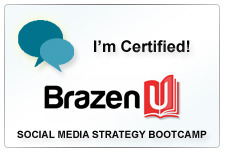
This is the final of a four-part series of class notes from the Social Media Bootcamp course, whose lessons I've adapted for authors. Whether self-published or traditionally so, you will be responsible for your own promotion, and this course has been an invaluable resource on how to use the Internet's no-cost social media networks wisely–in other words, (1) without mindless cruising, (2) without resenting the Internet for eating your writing time, and (3) without the frustration of posting stuff that people ignore.
Week 4 was all about tying together the first three weeks' lessons on how to find your audience, discover what they care about, enter the conversation, gauge your success, and correct course. The big takeaway should be a Plan-with-a-capital-P, in other words, a simple but specific schedule of what you'll post, when, and where. So, you can put a checkmark by (1)–no mindless cruising. At the end of this post, I include Exhibit A, the schedule that I developed for myself so that you can work on one of your own.
In adapting the course for authors, as an author, I will be the first to confess my initial view of social media marketing as a hybrid monster-cross of bleak duty and embarrassing self-exhibition. Therefore, I am now a vehement advocate for Goodreads as the most under-appreciated social network for writers. Facebook and Twitter have their place, but as a network that actually gives me energy, Goodreads is my home base. My self-promotion there is limited to occasional book giveaways and a portal to some of my free resources (like YouTube tutorials and this blog). I spend the rest of my time enjoying its smart and active forums (such as the one on Middle Eastern and North African literature), and taking book recommendations.
That's to say, Goodreads makes me strike a balance between social media participation and quiet hours offline. So, you can put a checkmark by (2)–no resenting the Internet for eating your writing time.
Finally, one of the most annoying and dispiriting aspects of social media marketing are the crickets. You know, the ones that you hear chirping after you update your status, post to Twitter, or write something on your blog. By building an intelligent plan for social media engagement, you can eliminate some of this silence. Not everything I'm trying right now is working, but my consistent attempts to improve has almost inadvertently increased my Twitter followers and blog traffic. The byproduct of an imperfect plan is information, and ultimately, more success.
Here are the three lessons I will live by for the rest of my social media life:
1. ALWAYS LISTEN FIRST!
2. The operational definition of social media is "a conversation about what my audience wants, on networks they go to anyway."
3. Be creative!
For my detailed breakdown of what I learned and how I made my plan, see below. Note, too, that I scheduled time to take a three-day break from the Internet every month. I'll leave you with this parting thought from the course planner, Penelope Trunk, whose advice I paraphrase here with apologies:
Blog on the border between your expertise and your curiosity. Don't write about what you already know. You'll come across as condescending rather than vulnerable.
+++++++++++
EXHIBIT A: SOCIAL MEDIA STRATEGY AND SCHEDULE
October 1, 2011
Networks, purpose, metrics
Blog (SC.com), to create a thoughtful and entertaining corner of the public forum that welcomes fellow web-savvy readers and writers. Measure success by hit count, comments, and invites to guest blog.
Blog (3PE), to provide a warm and understanding resource for unpublished writers, and promote EdLex. Measure success by hit count, Editor's Lexicon sales, RFIs, client successes, and new clients with really great manuscripts.
Blogs (others') via Google Reader, to connect with like-minded readers, writers, athletes, MENA thought-leaders, and queer women. Measure success by response to my comments, hit count on SC.com, subscriptions to my blog, and number of real connections through blog visits.
Goodreads, to share the passion of reading, to offer giveaways, interviews, and exclusive content. Measure success by growth of friend numbers, SC.com traffic, comments on my reviews and forum thoughts, and my own continuing desire to participate.
YouTube, to share knowledge in short tutorials, promote Editor's Lexicon and 3PE. Measure success by number of views and shares.
Google+, to post the most interesting material from my other networks. Measure success by circle adds, engagement.
Twitter via Hootsuite, to stay part of the book industry conversation, share resources, find new blogs, and promote material in other networks. Measure success by followers, Klout score, engagement, share of blog and YouTube hit count.
Goals
Sell Editor's Lexicon copies: (5-7 per week)
Improve engagement across the board
Get great clients: (1-2 RFIs per week, projects I love, client successes)
Establish a consistent, smart presence: (3-4 guest blog invites per year, steady increase in engagement everywhere)
Enjoy my reading and writing life: (Manage my time well, 1-2 hours of reading per day after writing and work)
The Schedule (8 hours 40 min per week)
MONDAY (1h 50)
Blog (mine): Resource or relevant thoughts, 1.5 hours
Twitter: 20 minute cruise and sharing, scheduled blog mention if applicable
TUESDAY (1h 40)
YouTube: Record 1-2 lessons, 1 hour
Blog (3PE): Share video and/or Monday's resource, 20 min.
Twitter: 20 minute cruise and sharing, scheduled random weekend finds if applicable
WEDNESDAY (1h 00)
Blog (mine): Book review from Goodreads, 10 minutes
Goodreads: Write book review, post YouTube video, cruise forums, 30 min
Google+: Share cross-posts, 10 min
Twitter: 10 minute cruise and sharing
THURSDAY (0h 40)
Blogs via Google Reader: 40 minutes
FRIDAY (1h 40)
Blog (mine): Literary or thoughts, 1.5 hours
Twitter: 10 minute cruise and sharing
WEEKEND (1h 50)
Goodreads: Fun participation, 1 hour
Blogs via GoogleReader: Find, read, comment, 30 minutes
Twitter: Find and schedule for Mon. and Tues., 20 minutes
MONTHLY
Guest blog post or interview on SC.com
Three-day social media blackout, stay offline for sanity's sake (Wed. through Fri.)
Random Observations:
- Twitter: posting interviews with popular novelists is almost always successful.
- Goodreads giveaways give a book a HUGE exposure advantage over any other tactic.
- SC.com blog visits on Saturdays lowest of week; don't waste my time blogging. Go outside and have fun.
September 29, 2011
Fiction or nonfiction?
A conversation on Goodreads sparked a question this morning. A reader mentioned that polls show a decline in for-pleasure reading after school, which reminded me of another poll I'd seen: Of the people who still pick up books in their spare time, fewer and fewer showed any interest in novels.
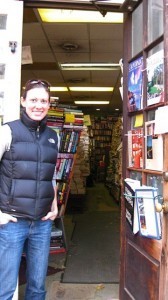
Salem bookshop, fall 2010
I wonder about reading fiction for pleasure versus reading nonfiction for, well, maybe not pleasure but at least personal edification. My best friend's father, a staunchly practical pathologist in Saudi, once told me–staunchly of course–"I don't read fiction. I don't like to be lied to." I've heard this opinion variously watered down over the years, always with either a note of apology or self-satisfaction. I have to admit, I understood my friend's father's reaction better than the apologetic or self-satisfied ones.
On one hand, at least they're reading. Great! But on the other, is fiction considered frivolous? A confection for one's extra-extra spare time? There is such a desire to be "smart" in our culture, with a paradoxical disdain of anything that tries to be intellectual; so are readers impelled to pick up nonfiction in their private hours to earn a share of voice in the next conversation? Our culture values speaking over listening, and nonfiction is more apt to give us something to say.
I read fiction and nonfiction both. I need them to keep both my heart and my mind open. Choosing a favorite would be like having to choose between dark chocolate and red wine.
What do you think?
September 26, 2011
Social Media for Authors: Week 3 of 4
If you spend a lot of time on social networking sites, are you wasting your time or getting results? Last week in Brazen Careerist's Social Media Bootcamp course, the focus was on how to answer this question. So far we learned:
Week 1′s lesson was to listen to your audience and figure out what they care about.
Week 2′s lesson was on how to create a social media strategy that connects your audience to your efforts on sites such as Twitter, Goodreads, blogs, and YouTube. In other words, how to pick your goals and make a plan that gets you there.
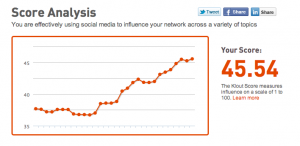
Week 3′s lesson was on how to calculate your return on investment (ROI) and use numbers to decide whether your efforts are paying off. The lessons required a lot of translation to make sense in the author's world, because–well, most likely, you're working solo. You don't have to justify your time to a boss. You're probably not famous, so you have to milk a lot of meaning from relatively smaller numbers. How? Forget the dollars-and-cents ROI calculations and just look at the numbers in relation to one another. To get your numbers, use these measuring tools:
Access Twitter through Hootsuite so that you can easily share links through ow.ly. Hootsuite allows you to create free reports that show not only your number of followers, but how many people click on your links. Note that Twitter is a great place to meet people and participate in conversations; in my case, though, the numbers revealed that I spend too much time here for the small level of engagement in return. I also learned that my followers are more likely to click on either how-to articles like this one, or on my book reviews.
Check your Klout score to watch for changes in the effectiveness of your tweets. Don't get addicted to the score. Instead, look for trends (is the graph going up or staying flat?), compare them to the efforts you've been making, and also learn from its matrix of participation styles. Hover your mouse over each square to read about it, and decide whether to change your sharing/tweeting style to suit your goals.
Participation style matrix
Connect your blog to Google Analytics.It provides information on your number of new and repeat visitors, where they come from, what pages they're interested in, and how long they hang around your site. It also gives you valuable SEO insights, such as the keyword searches that led people to your blog. This was my wakeup call: Most of my site visitors find me through Google searches; also, though I have only 40 friends on Goodreads but almost 1,000 Twitter followers, I get more visitors from Goodreads than from Twitter. Therefore, I should focus even more time on SEO optimization and on my interactions on Goodreads.
Screenshot of my Analytics page
Use the Author Dashboard in Goodreads to find out how many people added your book to their "to read" list, how many people clicked on your blog posts, how many "liked" your posts, and how many new friends and fans you have. Remember, though, that Goodreads is not a place to actively promote yourself. Pay the most attention to what people are reading, sharing your own reviews, and of course, reading books offline. You're a writer. Read. A lot.
Bottom line, THESE ARE ALL NUMBERS. You measure them over time to find out what ideas, tone of voice, and participation style works in your social media world. Don't get addicted to them for their own sake. Your social media world is a tiny bubble of your life at large, in which the true focus is still on staying healthy, exposing your mind to a 360-degree horizon of ideas, and writing well. When you do step out into the world to sell books, find a publisher, or establish a credible presence as a writer, the numbers will tell you how you're doing and how to make the best use of your time.
September 23, 2011
Confessions of a bibliophile
 The winter of 2000 was my junior year in college. It was a nocturnal, cloistered, literary year, and I lived in a triangle between Carnegie Mellon's English building, the 61C coffee shop on Murray Avenue, and Three Penny Books, a used bookstore next door to the cafe. Its owner was an insomniac who kept the store open well past last-call, and he drew most of his business from a late-night crowd of students and the neighborhood's sleepless old men. On my way home from studying, if the bus schedule allowed, I'd peruse the sidewalk cart in the glow of the front window's Christmas lights, or go inside and examine the serpentine trail of novels that rounded the baseboards.
The winter of 2000 was my junior year in college. It was a nocturnal, cloistered, literary year, and I lived in a triangle between Carnegie Mellon's English building, the 61C coffee shop on Murray Avenue, and Three Penny Books, a used bookstore next door to the cafe. Its owner was an insomniac who kept the store open well past last-call, and he drew most of his business from a late-night crowd of students and the neighborhood's sleepless old men. On my way home from studying, if the bus schedule allowed, I'd peruse the sidewalk cart in the glow of the front window's Christmas lights, or go inside and examine the serpentine trail of novels that rounded the baseboards.
Two years later, after a series of semi-connected events that included 9/11, graduation, a cross-country move to Oregon, and quitting a dead-end job, I started my book editing business. In honor of Three Penny Books, I called it The Threepenny Editor. And at Christmastime, I went back to Pittsburgh for a visit and had my first real conversation with the owner; I gave him my card and told him how much his store meant to me. In one of life's sad synchronicities, he told me that he was closing the store in a few weeks; like so many booksellers, he was pulling up stakes and moving his shop online.
 We became friends. We started a thing that didn't go well. But when he dispatched the last of his inventory, he made a generous gift that ranked among one of the best I've received in my life: the Encyclopedia Britannica 11, a noiseless Remington portable typewriter, a 1936 Royal typewriter, and a bookshelf of Orientalist relics ranging from Charles Doughty's Travels in Arabia Deserta to Albert Hourani's A History of the Arab Peoples to N.M. Penzer's The Harem.
We became friends. We started a thing that didn't go well. But when he dispatched the last of his inventory, he made a generous gift that ranked among one of the best I've received in my life: the Encyclopedia Britannica 11, a noiseless Remington portable typewriter, a 1936 Royal typewriter, and a bookshelf of Orientalist relics ranging from Charles Doughty's Travels in Arabia Deserta to Albert Hourani's A History of the Arab Peoples to N.M. Penzer's The Harem.
Fast forward again, to five homes and four states later. These artifacts of Three Penny Books sit about six feet from my desk. They look nice but I usually don't think about them. I have a business to run; and until my wife finishes medical school, I do all the cooking and housekeeping. Although people remember Sisyphus for struggling eternally with his boulder, he should have been glad not to have the task of cooking for two marathoners. I find that the mundane has a way of fogging up days at a time, and I wonder what my twenty-year-old self would think about living in San Antonio and being known among friends mainly for the quality of her stuffed mushrooms.
Literary ecumenicalism is stamped all over my memory of that bookstore, twisted into its front-window Christmas lights, inseparable from memories of college and coffee and walking home with a messenger bag full of books at midnight in a rainy Pittsburgh winter.
And I realized this made me sad. So yesterday, I turned off the computer. I watered the garden. And then, purely for the hell of it, I pulled N.M. Penzer's The Harem off the shelf. I discovered that the illustrations among its broad, yellowed pages fold out into maps of the sultan's palace, and that all male heirs to the throne were educated and imprisoned in a royal school called The Cage. But mostly, the book evoked Pittsburgh winters and being twenty and so absolutely excited about a brilliant, unknown future that I could afford to take my optimism about it for granted.
You know what I love about books? As easily as a map unfolds from the leaves of a forgotten volume, the right one at the right time can relocate one's sense of curiosity and optimism. The uncharted world of a new manuscript is one of the few pristine frontiers left to explore. So today, on this first day of fall, I'm putting aside the spiritual catatonia that always descends between novels, and resolving to outline my next project by the end of October.

